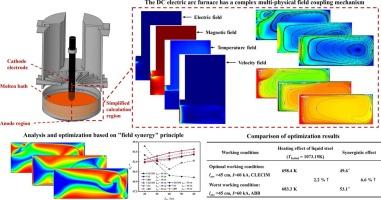基于运行参数和场协同分析的直流电弧炉多物理场建模与优化
IF 5.4
3区 工程技术
Q2 ENERGY & FUELS
引用次数: 0
摘要
全球钢铁行业在提高能源效率和减少环境影响方面面临越来越大的压力,这凸显了优化工业加热过程的全球意义。对于直流电弧炉(DC EAF)来说,优化多物理场对于提高生产效率和降低能耗至关重要。本研究使用多物理场协同方法研究直流电弧炉,为改善电弧参数和电极配置的控制提供见解。采用磁流体动力学(MHD)模型进行数值模拟,研究紧跟国际先进冶金研究的趋势。MHD模型模拟了炉内的电磁、速度和温度场。然后评估阳极结构、弧长和电流如何影响这些场。通过应用场协同原理,优化这些场之间的相互作用,以提高传热效率。结果表明,改变电弧参数(弧长和电流)和阳极结构可以显著改善速度场和温度场之间的协同作用,增强传热能力。受熔池底部洛伦兹力变化的影响,在不同条件下出现了三种不同的钢液流动模式。电弧长度为45厘米,电弧电流为60 kA,采用cleecim阳极结构,实现了最佳性能。与最不优方案相比,温度-速度场协同效应提高了6.6%,温升提高了2.2%。这些成果通过提供可扩展的、节能的运营框架,为全球可持续钢铁生产提供支持,对研究和工业都具有重大价值。本文章由计算机程序翻译,如有差异,请以英文原文为准。

Multi-physics modeling and optimization of DC electric arc furnace based on operating parameter and field synergy analysis
The global steel industry is under growing pressure to boost energy efficiency and reduce environmental impacts, highlighting the worldwide significance of optimizing industrial heating processes. For Direct Current Electric Arc Furnaces (DC EAF), optimizing multi-physical fields is essential to increase productivity and lower energy use. This study examines DC EAFs using a multi-physical field synergy approach, offering insights to improve control of arc parameters and electrode configurations. Using a magnetohydrodynamic (MHD) model for numerical simulation, the research follows international trends in advanced metallurgical studies. The MHD model simulates the electromagnetic, velocity, and temperature fields within the furnace. It then evaluates how anode structure, arc length, and current affect these fields. By applying the field synergy principle, interactions among these fields are optimized to boost heat transfer efficiency. Results show that modifying arc parameters (arc length and current) and anode structure significantly improves the synergy between velocity and temperature fields, enhancing heat transfer. Three distinct molten steel flow patterns emerge under different conditions, influenced by changes in the Lorentz force at the bath base. Optimal performance is achieved with an arc length of 45 cm, arc current of 60 kA, and the CLECIM anode structure. Compared to the least optimal scenario, temperature–velocity field synergy improves by 6.6 %, and temperature rise increases by 2.2 %. These outcomes support global sustainable steel production by offering a scalable, energy-efficient operational framework, holding substantial value for both research and industry.
求助全文
通过发布文献求助,成功后即可免费获取论文全文。
去求助
来源期刊

Thermal Science and Engineering Progress
Chemical Engineering-Fluid Flow and Transfer Processes
CiteScore
7.20
自引率
10.40%
发文量
327
审稿时长
41 days
期刊介绍:
Thermal Science and Engineering Progress (TSEP) publishes original, high-quality research articles that span activities ranging from fundamental scientific research and discussion of the more controversial thermodynamic theories, to developments in thermal engineering that are in many instances examples of the way scientists and engineers are addressing the challenges facing a growing population – smart cities and global warming – maximising thermodynamic efficiencies and minimising all heat losses. It is intended that these will be of current relevance and interest to industry, academia and other practitioners. It is evident that many specialised journals in thermal and, to some extent, in fluid disciplines tend to focus on topics that can be classified as fundamental in nature, or are ‘applied’ and near-market. Thermal Science and Engineering Progress will bridge the gap between these two areas, allowing authors to make an easy choice, should they or a journal editor feel that their papers are ‘out of scope’ when considering other journals. The range of topics covered by Thermal Science and Engineering Progress addresses the rapid rate of development being made in thermal transfer processes as they affect traditional fields, and important growth in the topical research areas of aerospace, thermal biological and medical systems, electronics and nano-technologies, renewable energy systems, food production (including agriculture), and the need to minimise man-made thermal impacts on climate change. Review articles on appropriate topics for TSEP are encouraged, although until TSEP is fully established, these will be limited in number. Before submitting such articles, please contact one of the Editors, or a member of the Editorial Advisory Board with an outline of your proposal and your expertise in the area of your review.
 求助内容:
求助内容: 应助结果提醒方式:
应助结果提醒方式:


